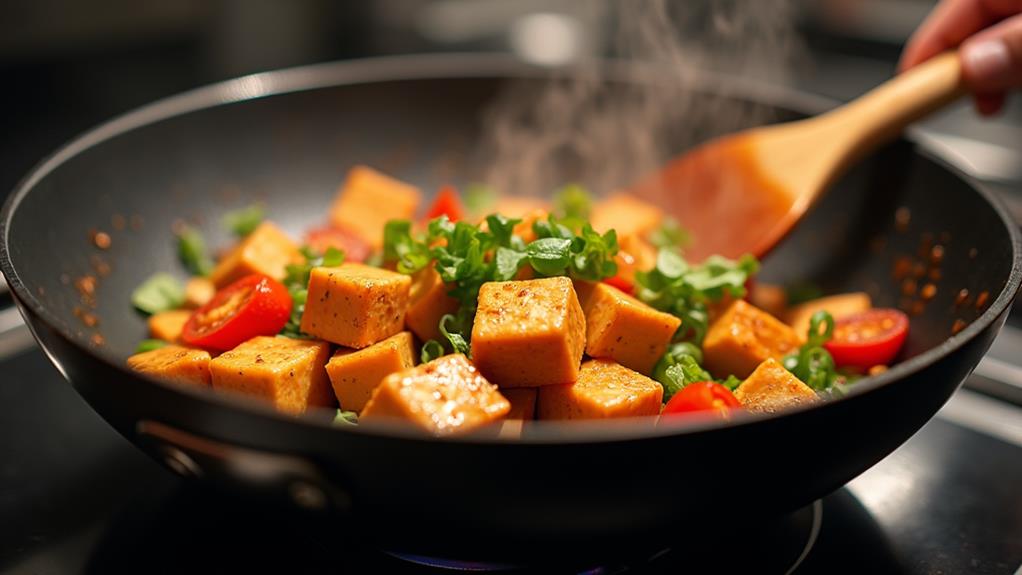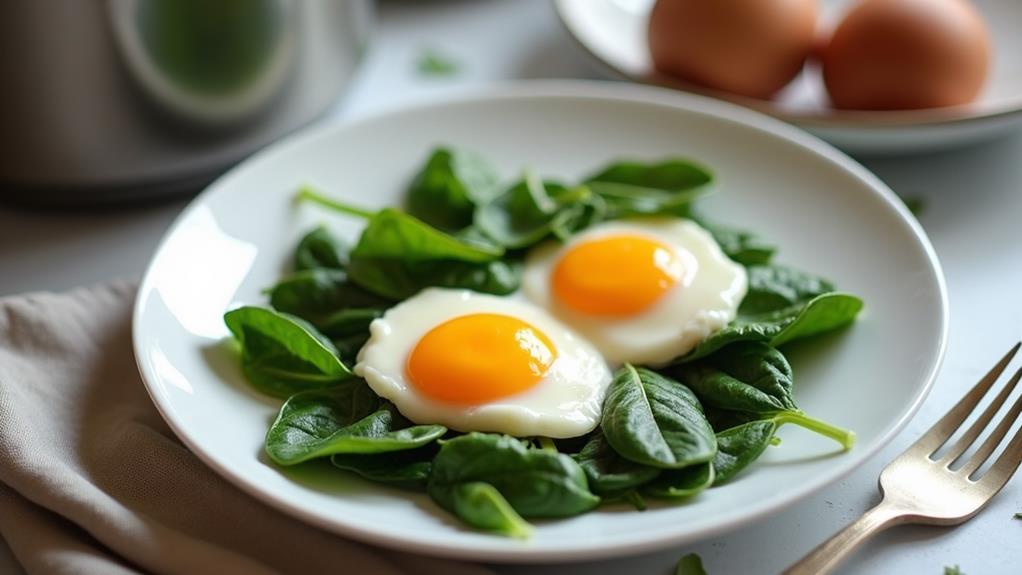To unlock the secrets of low-calorie cooking, you'll need to master several tantalizing techniques. Start by embracing healthy sautéing methods using non-stick pans and minimal oil. Enhance flavors with herbs, spices, and marinades instead of high-calorie sauces. Choose nutrient-dense ingredients like leafy greens, berries, and lean proteins to create satisfying meals. Implement portion control strategies and meal planning to maintain calorie awareness. Quick meal prep techniques, such as batch cooking, will streamline your efforts. By exploring versatile cooking methods and experimenting with global cuisines, you'll discover a world of delicious, slimming meals that support your health goals. Dive deeper to uncover more culinary secrets that will revolutionize your approach to low-calorie cooking.
Mastering Healthy Sautéing Techniques
Three key techniques can transform your sautéing into a healthier cooking method.
First, revolutionize your pan choice. Opt for a high-quality, non-stick skillet that allows you to use less oil while still achieving that perfect golden sear, a technique that echoes the principles of roasting root vegetables for maximum flavor. This simple switch can significantly reduce calorie intake without sacrificing flavor.
Next, master the art of oil misting. Instead of liberally pouring oil into your pan, invest in an oil mister. This innovative tool lets you evenly coat your ingredients with a fine layer of healthy fats, such as olive or avocado oil.
You'll use far less oil while ensuring even cooking and flavor distribution. Incorporating techniques like enhancing flavor with herbs can elevate your dishes even further, creating delicious, healthy meals.
Ideal Cookware and Oils
Building on our healthy sautéing techniques, let's explore the best cookware and oils for low-calorie cooking. Non-stick pans are your secret weapon in the battle against excess calories. These innovative kitchen tools allow you to cook with minimal oil, reducing fat content without sacrificing flavor.
For instance, using roasted vegetables, a common element in many healthy dishes such as herbed quinoa salads, can enhance taste while keeping meals light. Opt for high-quality ceramic or PTFE-free non-stick surfaces to ensure durability and safety.
When it comes to oils, it's crucial to choose wisely. Healthy oils like olive, avocado, and coconut not only add depth to your dishes but also offer nutritional benefits. These oils have higher smoke points, making them ideal for various cooking methods. Use them sparingly, though – a little goes a long way in low-calorie cooking.
Don't forget about spray oils, which can be a game-changer in portion control. They allow you to evenly coat your pan with a fine mist, significantly reducing the amount of oil used.
For even more control, invest in an oil mister to create your own custom blends. By combining the right cookware with carefully chosen oils, you'll master the art of creating delicious, low-calorie meals that satisfy both your taste buds and your health goals.
Selecting Nutrient-Dense Ingredients

Choosing nutrient-dense ingredients is key to creating low-calorie meals that pack a nutritional punch. When you're aiming to slim down your dishes, focus on superfood selection to maximize health benefits while minimizing calorie intake.
Lentils, for instance, are a fantastic source of plant-based protein and fiber, making them a perfect option for boosting satiety while keeping calories low. Opt for leafy greens like kale and spinach, which are low in calories but rich in vitamins and minerals. Additionally, consider incorporating spring greens like watercress for added flavor and nutrition, as noted in Lentils With Spring Greens & Watercress Walnut Pesto.
Berries, such as blueberries and strawberries, offer antioxidants and natural sweetness without excess sugar.
Ingredient substitutions can revolutionize your low-calorie cooking. Replace high-fat dairy with Greek yogurt or cottage cheese to boost protein content while reducing calories. Swap refined grains for whole grains like quinoa or brown rice to increase fiber and nutrients.
Experiment with plant-based proteins such as lentils or tofu, which are lower in calories than many animal proteins. When selecting produce, choose vibrant, colorful options that signal higher nutrient density.
Flavorful Seasonings and Marinades
Countless flavorful seasonings and marinades can transform low-calorie dishes from bland to delicious without adding significant calories. You'll discover a world of taste-enhancing options that'll elevate your healthy meals.
Experiment with herb combinations like rosemary and thyme or basil and oregano to infuse your dishes with aromatic complexity. Create your own spice blends, mixing paprika, cumin, and coriander for a Middle Eastern flair, or combine chili powder, garlic powder, and onion powder for a zesty Tex-Mex taste.
Citrus marinades are excellent for lean proteins, imparting bright flavors while tenderizing meat. Incorporate umami boosters like mushroom powder or nutritional yeast to add depth without excess sodium.
Replace sugar with sweetener alternatives such as stevia or monk fruit in your marinades. Vinegar infusions, like apple cider or balsamic, can add tangy notes to your dishes.
Explore garlic variations, from roasted to black garlic, for intense flavor without added fat. Finally, introduce smoky flavors using smoked paprika or liquid smoke to mimic the taste of grilled foods without the extra calories.
Portion Control and Meal Planning

While flavoring techniques can make low-calorie meals more enjoyable, mastering portion control and meal planning is key to maintaining a healthy diet. By understanding caloric density and practicing mindful eating, you'll revolutionize your approach to food consumption.
Start by familiarizing yourself with appropriate serving sizes for different food groups, then use smaller plates to create the illusion of fuller portions. Invest in a food scale to accurately measure ingredients, ensuring you're not unknowingly overeating.
Meal planning is another crucial aspect of successful low-calorie cooking. Prepare meals in advance to avoid impulsive, high-calorie choices when you're pressed for time.
Consider these innovative strategies:
- Use meal prep containers with built-in portion control compartments
- Experiment with "volumetrics" by incorporating low-calorie, high-volume foods
- Create a weekly menu that balances nutrients and keeps calories in check
Quick Meal Prep Strategies
Meal prep's biggest advantage is its time-saving potential, but it's essential to develop quick and efficient strategies. To maximize your meal prep efficiency, start by planning your weekly menu in advance. This allows you to streamline your grocery shopping and avoid unnecessary purchases.
Invest in high-quality storage containers that are microwave-safe and stackable, optimizing your refrigerator space.
Embrace batch cooking techniques to prepare multiple meals simultaneously. Roast a variety of vegetables on a single sheet pan, or use your slow cooker to make large portions of soups and stews.
Implement a "cook once, eat twice" approach by preparing extra proteins that can be repurposed throughout the week. For instance, grilled chicken can be used in salads, wraps, or stir-fries.
Utilize time management techniques to make the most of your prep sessions. Set a timer for each task and challenge yourself to work efficiently. Pre-chop vegetables and portion out snacks for grab-and-go convenience.
Versatile Sautéing for Variety

Sautéing stands out as a versatile cooking technique that'll add variety to your low-calorie meal prep routine. By mastering different sautéing styles, you'll transform simple ingredients into flavorful, health-conscious dishes.
Experiment with dry sautéing, which uses minimal oil, or try water sautéing for an ultra-low-calorie option. These methods allow you to cook vegetables, lean proteins, and even fruits to perfection while keeping calories in check.
To maximize the benefits of sautéing in your low-calorie cooking arsenal:
- Invest in a high-quality non-stick pan to reduce the need for added fats
- Master the art of high-heat, quick-cooking to preserve nutrients and textures
- Experiment with ingredient swaps, like using vegetable purees as a sauce base
Don't be afraid to push the boundaries of traditional sautéing. Try incorporating unique spice blends or aromatic herbs to elevate flavors without adding calories.
You can also explore Asian-inspired stir-frying techniques or French-style deglazing to create complex, satisfying dishes. By embracing these innovative approaches, you'll discover that sautéing isn't just a cooking method, but a gateway to endless low-calorie culinary possibilities.
Frequently Asked Questions
How Can I Make Low-Calorie Meals More Filling and Satisfying?
You'll revolutionize your low-calorie meals by embracing fiber-rich ingredients like quinoa and lentils. Master portion control with innovative plating techniques. Experiment with spices and herbs to amplify flavors. You're crafting satisfying, slimming dishes that'll keep you energized.
Are There Any Specific Kitchen Gadgets That Help With Low-Calorie Cooking?
Where there's a will, there's a way! You'll love the spiralizer's benefits for creating veggie noodles and the air fryer's advantages for crispy, oil-free cooking. These innovative gadgets revolutionize your low-calorie cooking, making healthy meals a breeze.
Can I Still Enjoy Desserts While Following a Low-Calorie Diet?
You can absolutely indulge in desserts while watching calories! Explore innovative dessert substitutions and guilt-free treats. Try frozen fruit sorbets, Greek yogurt parfaits, or baked apples with cinnamon. Get creative and satisfy your sweet tooth without compromise!
How Do I Handle Social Situations and Eating Out on a Low-Calorie Diet?
You'll be a social dining superstar! Master menu navigation tips: opt for grilled dishes, ask for dressings on the side, and choose smaller portions. Don't shy away from events—embrace them with smart strategies and innovative low-calorie choices.
What Are Some Common Mistakes to Avoid When Cooking Low-Calorie Meals?
Don't skimp on flavor or overcompensate with excessive portions. You'll sabotage your efforts by neglecting proper seasoning or misunderstanding portion sizes. Instead, focus on innovative flavor enhancement techniques and practice mindful portion control for successful low-calorie cooking.
Final Thoughts
You've now unlocked the secrets to tantalizing, low-calorie cooking. As you experiment with these techniques, you'll discover a world of flavor that doesn't compromise your health goals. But what's next? The real challenge lies in consistently applying these methods to transform your daily meals. Will you rise to the occasion and revolutionize your cooking habits? Remember, mastery takes practice. Embrace this journey, and you'll soon find yourself effortlessly creating delicious, slimming meals that nourish both body and soul.















